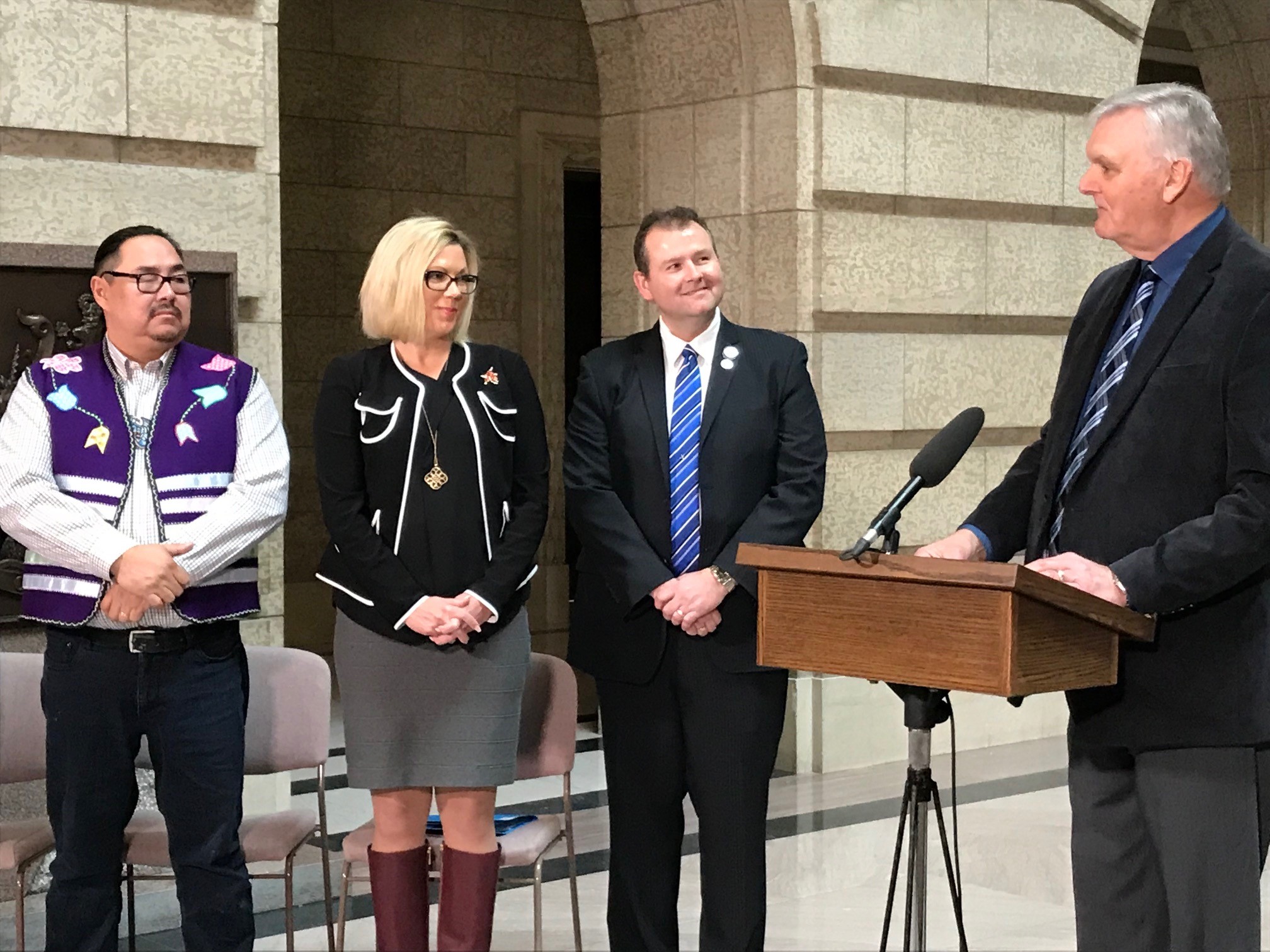
Share this publication:
On February 28, 2019, the Province of Manitoba made an announcement that will go down in history: it is transferring the Pine Falls forest management licence to local First Nations communities.
Sheldon Kent – Chief of the Black River First Nation, Rochelle Squires – Minister of Sustainable Development, Edmond LaBossière – CDEM’s Chair at Manitoba’s Legislative Building
Since the permanent closure of Tembec’s pulp and paper mill in Pine Falls in 2009, all forestry operations have ceased. None of the handful of economic projects attempted have been successful.
On February 28, 2019, the Province of Manitoba and the First Nations communities of Hollow Water, Black River and Sagkeeng, and the Brokenhead Ojibway Nation signed a partnership agreement putting these communities in charge of forest management. This is a milestone achievement for the First Nations, a ground-breaking recognition that is an appropriate part of the national reconciliation process.
“As First Nations people, we have always been excluded from the decision-making table on the Pine Falls forest, even though it’s in our backyard,” says Sheldon Kent, Chief of the Black River First Nation. “Tembec had all the forest rights, got all the contracts, and pulled all the strings.”
The old Pine Falls paper mill
“That’s why, since the early 2000s, the First Nations communities have been working tougher to see how we could be involved. The Tembec closure opened a door for us.”
Chief Kent admits that the 2005 opening of the South Beach Casino, a project carried out and wholly owned by a First Nations partnership, including Black River, gave wings to their dream. “It proved that we were capable of implementing successful multi-million dollar projects,” he says.
After that, nothing could stop them. As the project leader on behalf of the four local First Nations involved, Chief Sheldon Kent enlisted the support of CDEM and Terry Brown, a business consultant with Legacy Bowes Group, to achieve today’s historic transfer.
“We want to work in collaboration with all the local communities, both First Nations and not,” says Chief Kent. “It’s a win-win for everyone, including the CDEM bilingual communities. We also want universities at the table. It’s necessary to lay the foundation for success.”
Two years to launch the project
Terry Brown points out that “the licence granted by the Province is for a two-year renewable term, which should be enough time to develop the proposed forestry project and train the workforce.”
The partners still have to explore their options. “Ideally, we would like to follow the example of Quebec’s Chantiers Chibougamau, which sells its finished wood products directly to the United States,” says Chief Sheldon Kent.
“But there is still a lot to do to get to that point, including a forest inventory, given that the area ‘s sizeable river beaver population may have done some damage. Following that assessment, we will be in a better position to determine the direction of our business.”
There are many possibilities, including biodiesel, and cross-laminated or glue-laminated timber. Wood is increasingly being used in major structural projects, such as bridges. “When people hear ‘forest,’ they often think sawmill, but there are many other things that can be done with wood,” says Chief Kent.
Glue-laminated timber bridge
“There is a high level of demand, both for the product and the technology,” says Terry Brown. “For instance, in Sweden, compacted sawdust pellets are used for heating. The key thing is to prepare a model that can be tailored to the times, unlike the pulp and paper mill of the past.”
While the investment required for forestry restoration may be quite high, the Chief does not expect financial assistance from the Province. “We know that the Province is dealing with a deficit. What’s important to us is the licence; from there, we can build a solid business plan.”
The RDÉE Canada (Réseau de développement économique et d’employabilité du Canada) network of which CDEM is a member is pleased to have contributed to the effort.
Louis Allain – CEO of CDEM, Edmond LaBossière – CDEM’s Chair, Jean-Guy Bigeau – CEO of RDÉE Canada, Terry Brown – Business Consultant with Legacy Bowes Group, Sheldon Kent – Chief of the Black River First Nation
“We have worked together on this initiative for three years,” says Jean-Guy Bigeau, CEO of RDÉE Canada, which promotes the economic development of Francophone and Acadian communities in Canada. “We arranged a number of highly productive meetings with key stakeholders in our network, and we will continue to do everything possible to make this historic partnership a success.”
CDEM’s Chair, Edmond Labossière, says he is “impressed with the advanced state of collaborative readiness of all the confirmed potential partners. It’s very positive, and the First Nations are providing outstanding leadership in this undertaking.”
“With this forest management licence, we can finally realize the dream we have been working on all these years,” says Chief Sheldon Kent. “It will still take time, energy and capital, but we are ready.”
Read more on Ici Manitoba: Des Premières Nations exploiteront la forêt de Pine Falls
© 2025 , Conseil de développement des municipalités bilingues du Manitoba. All rights reserved.
Website : InnovaCom Marketing et Communication